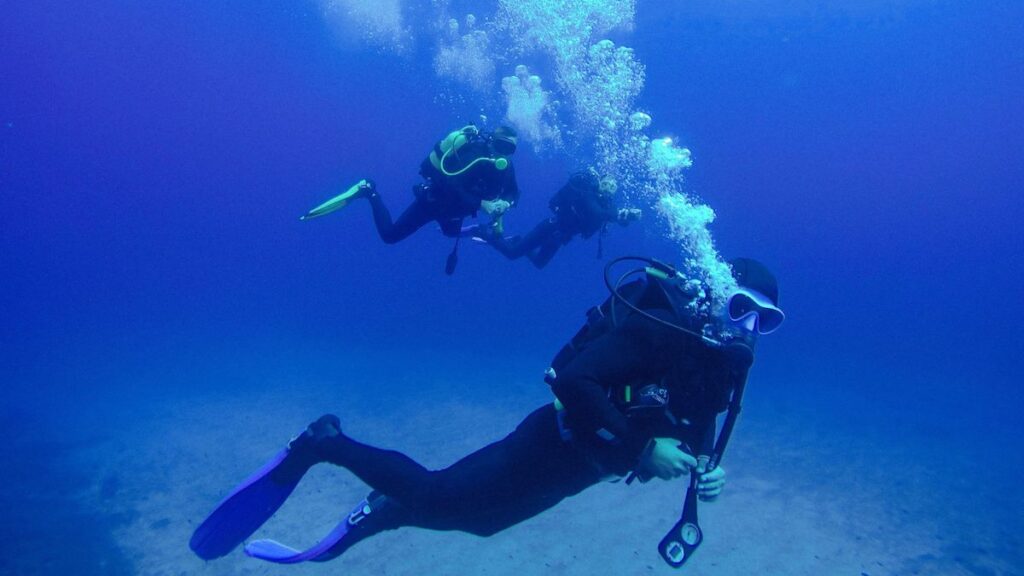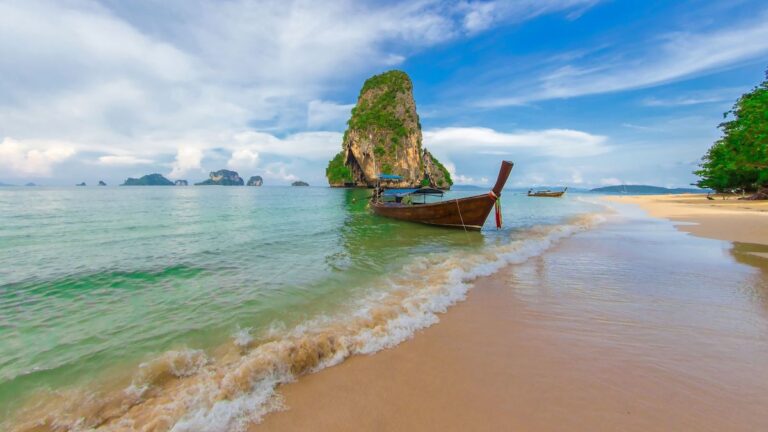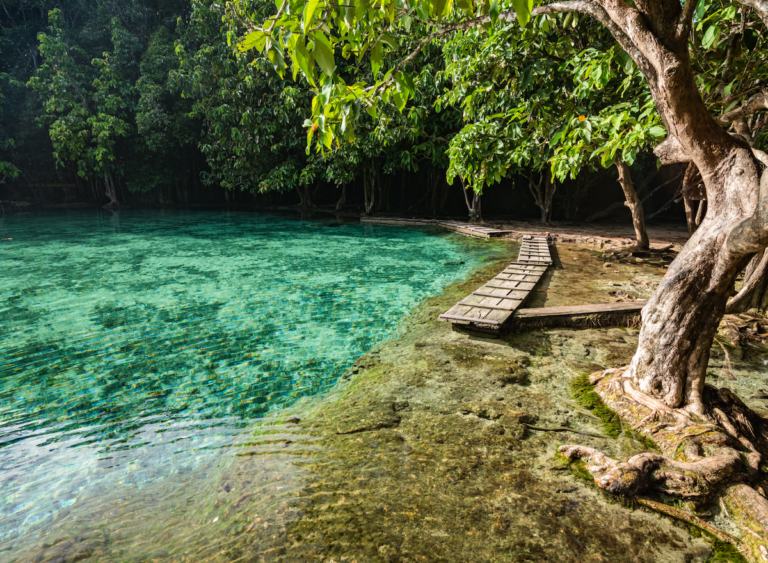Diving in Krabi and Koh Phi Phi
Anemone Reef, Shark Point, King Cruiser Wreck… even the names of the dive sites around Krabi convey a sense of adventure. The Andaman coast is recognized throughout the world as excellent for diving. Its tropical waters are home to thousands of species of fish and coral, including leopard and whale sharks (both harmless!), turtles, moray eels, and dolphins.
There are more than 40 scuba diving schools in Krabi and Phi Phi, all of which cater to licensed divers as well as beginners. In fact, the relatively low prices and clear, shallow waters of the Andaman Sea make Krabi an ideal place to learn diving.
Diving in Krabi for Beginners
PADI* Open Water courses (the qualification needed to obtain a diving license) takes around three to four days to complete, or you can do a taster day called ‘Discover Scuba Diving’. Both courses are supervised by qualified Western instructors, who between them speak most of the major European languages, and there is always a practice session in a swimming pool before you jump in!
Once you experience diving, as one recent graduate of the Open Water course here describes, ‘it’s like swimming in an amazing aquarium’. The opportunity to view the beautiful, and often strange, marine life up close is something you will never forget. If you become hooked, it’s also possible to increase your skills and knowledge by completing any of the PADI series of qualifications and specialty courses, right up to the dive instructor level.
All equipment is provided and includes introductory dives and safety instructions. You can then dive anywhere in the world with this certification. Thailand is one of the cheapest, most comfortable, and most beautiful places in the world to complete a dive course. The Open Water PADI course costs about 15,500 THB, or you can opt for a one-off discover scuba program (lasting a day, with two dives) for about half that.
Of course, not everyone is able to dive. People with certain medical conditions, including those with heart and lung issues, along with pregnant women and children under the age of seven, are some of them. If in doubt, it is best to seek medical advice from your doctor before you leave for Thailand. They can also write you a clearance form which is required for insurance purposes.
Non-divers can still enjoy the underwater world on snorkeling trips – even if you are not a strong swimmer, life jackets are provided to help you stay afloat while you watch the shoals of multi-colored fish swim by. You can join an excursion on a dive boat, or take a boat trip dedicated to snorkellers; equipment is always provided.
Diving in Krabi for Experienced Divers
 Krabi is one of several popular centers in Thailand for diving, and where you choose to dive can depend on the season and your personal preference for the area once you are out of the water. In this respect, Krabi has far more to offer than Phuket and Koh Tao, with reasonable prices, a decent amount of activity, and facilities, along with other pursuits, such as rock climbing and unbeatable scenery.
Krabi is one of several popular centers in Thailand for diving, and where you choose to dive can depend on the season and your personal preference for the area once you are out of the water. In this respect, Krabi has far more to offer than Phuket and Koh Tao, with reasonable prices, a decent amount of activity, and facilities, along with other pursuits, such as rock climbing and unbeatable scenery.
Talk with the staff in a local dive center to see which course or site would be suitable for your level of experience. You will also get a chance to meet the instructors – it is important, if you are diving, that you find one you can communicate well with. If you are an experienced diver, you may also like to find out about the center’s equipment and boat and check the dive briefs for the sites. All this information is available in the shops.
In general, diving in Krabi is world-class and monitored by experienced international staff. This particular sport is mainly operated by Westerners in Thailand and you can expect the same standards of safety as you would anywhere in the world, with modern equipment and prices up to half of other popular areas such as the Caribbean, Red Sea, and Australia. There is a hyperbaric recompression chamber in Phuket Town.
Open Ocean Dive Sites Near Krabi
-
King Cruiser Wreck
King Cruiser Wreck is a captivating dive site resting on the seabed since 1997, not far from Krabi. This 85-meter-long ferryboat was ferrying passengers between Phuket and Phi Phi Islands until it hit a submerged rock and sank. Today, it provides shelter for an array of marine life, such as barracudas, pufferfish, and lionfish. It’s also a great place to spot a leopard shark or two. However, make sure you’re an Advanced Open Water Diver as the site begins at 18 meters and drops to a maximum depth of 32 meters.
-
Shark Point
Shark Point is perched at a marine national park, south of Phuket, and is famed for its year-round resident leopard sharks. This dive site features three pinnacles covered in corals and sponges, creating a kaleidoscope of colors. The location is perfect for reef and macro photography, making it a favorite among underwater photographers. Besides leopard sharks, you can also find a range of marine life here, including blue-spotted stingrays, nudibranchs, and sea turtles.
-
Anemone Reef
Anemone Reef is a small rocky outcrop located in the Andaman Sea south of Phuket, covered in colorful anemones and home to plenty of clownfish, the ones made famous by the movie “Finding Nemo.” Underwater enthusiasts also flock to this dive site to see manta rays, whale sharks, and giant moray eels.
Diving at Koh Phi Phi
The island of Koh Phi Phi is home to over 20 dive sites suitable for both beginners and experienced divers. The most popular spots among divers are Maya Corner, Viking Bay, The Bidas (Bida Nok and Bida Nai), and Kred Gaeow Wreck. These sites boast good visibility, mild currents, and a wide range of sea life. Whether you are just starting your diving journey or looking to explore deeper waters, these dive sites guarantee a memorable experience.
Diving at Koh Phi Phi is a paradise for underwater photographers due to the abundance of vibrant soft corals and colorful reef fish. Hawksbill sea turtles, blacktip reef sharks, leopard sharks, and giant moray eels are a few of the remarkable sea creatures you could spot while diving. In addition, schools of fusiliers, giant barracudas, and snappers make up the diverse aquatic life at Koh Phi Phi.
The travel time from Ao Nang to Koh Phi Phi is around 2-2.5 hours, which means that you can still dive on the island even if you are located on the mainland. Despite the shallow depths of the dive sites, the maximum depth ranges from 25 to 30 meters at some locations, making it suitable for advanced divers as well. Diving at Koh Phi Phi boasts good water temperatures of around 27-30°C (80-85°F).
The best time to dive at Koh Phi Phi is between October and May. During this time, the weather conditions are favorable, the currents are mild, and visibility is excellent, ranging from 10 to 20 meters on average. Depending on your diving level and preference, you could either choose to explore the coral gardens or head towards the dark water of the Kred Gaeow Wreck.
Looking for alternatives? Travel from Krabi to Koh Lanta for even more amazing dive spots.
Diving at Ao Nang
With a variety of dive sites near Ao Nang, there’s a lot to choose from, but some are more desirable than others. The top picks for diving include Koh Yawabon, Koh Sii, and Koh Talu. Koh Yawabon, known for its vibrant colors and intricate coral reefs, is perfect for both beginner and advanced divers. Koh Sii is home to an abundance of marine life, such as reef sharks and barracudas, hovering just ten meters below the surface of the water. Another deepest dive site, Koh Talu, reaches a depth of twenty meters and features a stunning tropical landscape filled with seahorses and manta rays.
Before diving in, there are a few things to familiarize yourself with. Water temperature ranges from 27-30°C (80-85°F), which is ideal for a pleasant diving experience, and the moderate current makes it perfect for both novice and advanced divers. However, the visibility is poor if you’re accustomed to clearing water diving as the average visibility ranges from 2-12 meters. Despite the visibility, it’s still possible to enjoy the beauty of Ao Nang’s marine life.
When planning to visit Ao Nang’s nearby Islands, it’s crucial to know the best time to dive. October to May is when the water is the calmest and the weather is the most favorable. Although these months are the most ideal for diving, it’s still necessary to check the weather forecast before taking a plunge.
Another aspect to consider is the duration it takes to get to the dive sites. The ride to the Local Islands usually lasts 30-40 minutes from Ao Nang, which isn’t long considering the adventure waiting for you. With a range of depths from 0-20 meters, there’s a dive site suitable for every level of diver.
Sea life found at Ao Nang’s nearby islands includes barracudas, seahorses, nudibranchs, bamboo sharks, blue-spotted stingrays, and banded sea snakes. These curious and playful sea creatures can often be seen flitting in and out of the coral, making diving at Ao Nang a memorable experience.






